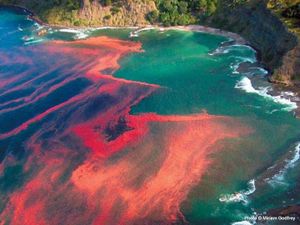Template:This weeks featured article
ALGADEC - Detection of toxic algae with a semi-automated nucleic acid biosensor
Microalgae are the major producers of biomass and organic compounds in the aquatic environment. Among the marine microalgae there are 97 toxic species (mainly dinoflagellates) known to have the potential to form "Harmful Algal Blooms", the so called HABs (Fig. 1). In recent decades, the public health and economic impacts of toxic algae species appear to have increased in frequency, intensity and geographic distribution (Zingone and Enevoldsen, 2000[1], Daranas et al., 2001[2], Hallegraeff, 2003[3], Moestrup, 2004.[4]). In order to minimise the damage to human health or living resources, such as shellfish and fish, as well as economic losses to fishermen, aquaculture and the tourist industry, efficient monitoring methods are required for monitoring potentially toxic algal species (identification and quantification) (Andersen et al., 2003.[5]).
In order to detect toxic algae in the field, a portable semi-automated nucleic acid biosensor was developed in the ALGADEC project www.algadec.net. This device enables the electrochemical detection of microalgae from water samples in less than two hours, without the need of expensive equipment.- ↑ Zingone, A. & Enevoldsen, H.O. (2000). The diversity of harmful algal blooms: a challenge for science and management. Ocean & coastal management, 43, 725-748.
- ↑ Daranas A. H., Norte M. and Fernandez, J. J. (2001). Toxic marine microalgae, Toxicon, 39, 1101-1132.
- ↑ Hallegraeff G. M. (2003). Harmful algal blooms: a global overview. In G.M. Hallegraeff, D.M. Anderson & A.D. Cembella (Eds.), Manual on Harmful Marine Microalgae (pp. 25-49). United Nations Educational, Scientific and Cultural Organization.
- ↑ Moestrup, O. (2004). IOC Taxonomic Reference list of Toxic Algae. In O. Moestrup (Ed.), IOC taxonomic reference list of toxic algae. Intergovernmental Oceanographic Commission of the UNESCO.
- ↑ Andersen P., Enevoldsen H. and Anderson, D.M. (2003). Harmful algal monitoring programme and action plan design. In G.M. Hallegraeff, D.M. Anderson & A.D. Cembella (Eds.), Manual on Harmful Marine Microalgae (pp. 627-647). United Nations Educational, Scientific and Cultural Organization.
